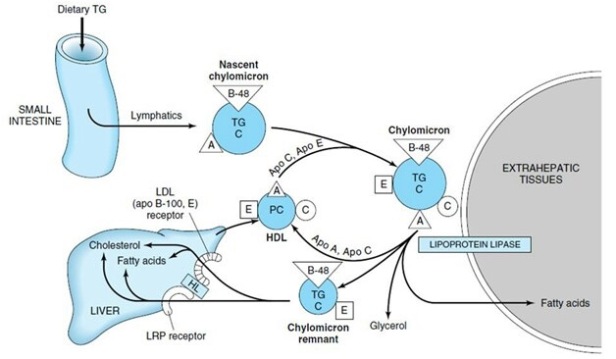Introduction to Lipid metabolism: digestion absorption and transport of lipids and MCQs
Lipid have a wide range of chemical substances such as: neutral fats, fatty acids, phospholipids, glycolipids, sterols etc. An adult consumes about 60-150gm of lipids every day. Out of this, 90% of fat in the diet is present as triacylglycerols and remaining are cholesterol, cholesterol esters, fatty acids and phospholipids.
Digestion of Lipids
Very less digestion occurs in the mouth and stomach. The main site of digestion for lipids is small intestine. In small intestine, the dietary lipids undergoes digestion using pancreatic enzymes.
Digestion in small intestine:- After the small digestion in stomach, the acid content of stomach known as chyme enters the duodenum of small intestine. Digestion of fat occurs in the duodenum by the emulsification process of fat. In the duodenum, the emulsification of fat is carried out by the action of bile salts.
- Hydrolysis of triacylglycerol:- after emulsification of triacylglycerol, they are hydrolyzed by the pancreatic lipase. lipases hydrolyzes the fatty acid in 1,3 positions of triacylglycerol and gives 2 monoacylglycerol and 2 molecules of fatty acids.
- Hydrolysis of dietary phospholipids:- glycerophospholipid are digested by pancreatic phospholipase-A2. This enzyme catalyzes the hydrolysis of fatty acid residue at the 2nd position of phospholipids which forms lysophospholipids and molecules of fatty acids.
- Hydrolysis of cholesterol esters:- these are hydrolyzed by pancreatic cholesterol ester hyrolase (cholesterol esterase) which forms cholesterol and fatty acids.
Products of Lipid digestion:- cholesterol, free fatty acids, lysophospholipids and 2-monoacylglycerol are the basic products of lipid digestion. All these products mix together with bile salts and form mixed micelles. Fat soluble vitamins are also packed in the mixed micelles. These vitamins are then absorbed from these micelles along with the dietary lipids.
Absorption of Lipids
- Absorption of lipids occur by the action of intestinal mucosal cells. The mixed micelles reaches the brush border of intestinal mucosal cells.
- Here the lipid components from mixed micelles are absorbed into the mucosal cells by diffusion.
- the net outcome is that all the primary products of digestion of lipids are transfer into the mucosal cells.
- After the absorption within the mucosal cells, 3 events takes place:
- the 2-monoacylglycerol is converted back to the triacylglycerol. This reaction is synthesized by the absorbed fatty acids from the lumen. The fatty acid are only utilized after its conversion to the active form, acyl-CoA.
- the absorbed lysophospholipids and cholesterols are again converted back to the phospholipids and cholesterols esters.
- all the formed products that are triacylglycerol, phospholipids and cholesterol ester combine together along with protein and absorbed fat soluble vitamins (A, D, E, K) to form chylomicrons.

- Image Source: https://rislyonline.wordpress.com/2017/06/12/digestion-absorption-of-fats/
Transport of absorbed Lipids
- Triacylglycerol, phospholipids, cholesterol esters and absorbed fat soluble vitamins are transported from mucosal cells to the lymph in the form of lipoprotein known as chylomicrons. The composition of chylomicrons is:
- triacylglycerol (85-90%)
- cholesterol and cholesterol ester (5%)
- phospholipids (7%)
- protein- apolipoprotein(1-2%)
- The chylomicrons pass from the lymph into the blood through the thoracic duct and are delivered to the liver.

Multiple choice questions (MCQs)
- Where do digestion of lipids occur?
A. stomach B. mouth
C. small intestine D. all of the above - In which form the digested product of stomach reaches the small intestine?
A. micelles B. emulsified fat
C. chyme D. lipoproteins - Where does the emulsification of fat take place?
A. duodenum B. fundus
C. jejunum D. ileum - What is the product after hydrolysis of triacylglycerol?
A. 2-monoacylglycerol B. cholesterol
C. free fatty acids D. both A and C - Match the following-
a. hydrolysis of triacylglycerol 1. apolipoprotein
b. mixed micelles 2. Phospholipase-A2
c. hydrolysis of phospholipid 3. Fatty acids
d. chylomicrons 4. lipases - Which enzyme catalyzes the hydrolysis of fatty acid residue?
A. lipases B. phospholipase-A2
C. cholesterol esterase D. none of the above - Which of the following is not the constituent of mixed micelles?
A. vitamin K B. Vitamin A
C. Vitamin B12 C. vitamin D - Which of the following statement is NOT true?
A. lipids are transported as chyme
B. water soluble vitamins are not included in chylomicrons
C. active form of fatty acid is acyl-CoA
D. apolipoprotein is a constituent of chylomicrons - Through which transport process, the lipid components are absorbed into the mucosal cells?
A. active transport B. passive transport
C. simple diffusion D. facilitated transport - What is the active form of fatty acids?
A. acyl-CoA B. acetyl-CoA
C. aryl-CoA D. alkyl-CoA - Which of the following is counted under the composition of chylomicrons?
A. monoacylglycerol B. fatty acids
C. lysophospholipids D. none of the above - Through which duct the absorbed lipid is transported to the blood?
A. thoracic duct B. abdominal duct
C. pelvic duct D. all of the above - Which protein is present in the chylomicrons?
A. myoglobin B. apolipoprotein
C. apoferritin D. actin - Which enzymes are majorly used for digestion of lipids?
A. salivary enzymes B. gastric enzyme
C. pancreatic enzyme D. none of the above - What products are obtained from the hydrolysis of cholesterol ester?
A. cholesterol and proteins B. cholesterols and fatty acids
C. cholesterols and ester D. cholesterol and phospholipids
ANSWERS:-
1. all of the above
2. chyme
3. duodenum
4. both A and C
5. a – 4 2 – 3 c – 2 d – 1
6. phospholipase-A2
7. vitamin B12
8. lipids are transported as chyme
9. simple diffusion
10. acyl-CoA
11. none of the above
12. thoracic duct
13. apolipoprotein
14. pancreatic enzymes
15 cholesterol and fatty acids
Participate in Online FREE GPAT TEST: CLICK HERE
Participate in Online FREE Pharmacist TEST: CLICK HERE
Participate in Online FREE Drug Inspector TEST: CLICK HERE
Participate in CSIR NET JRF Mock Test
REFERENCE:- Pankaja Naik- Biochemistry; 4th edition; page no:- 207-210 .